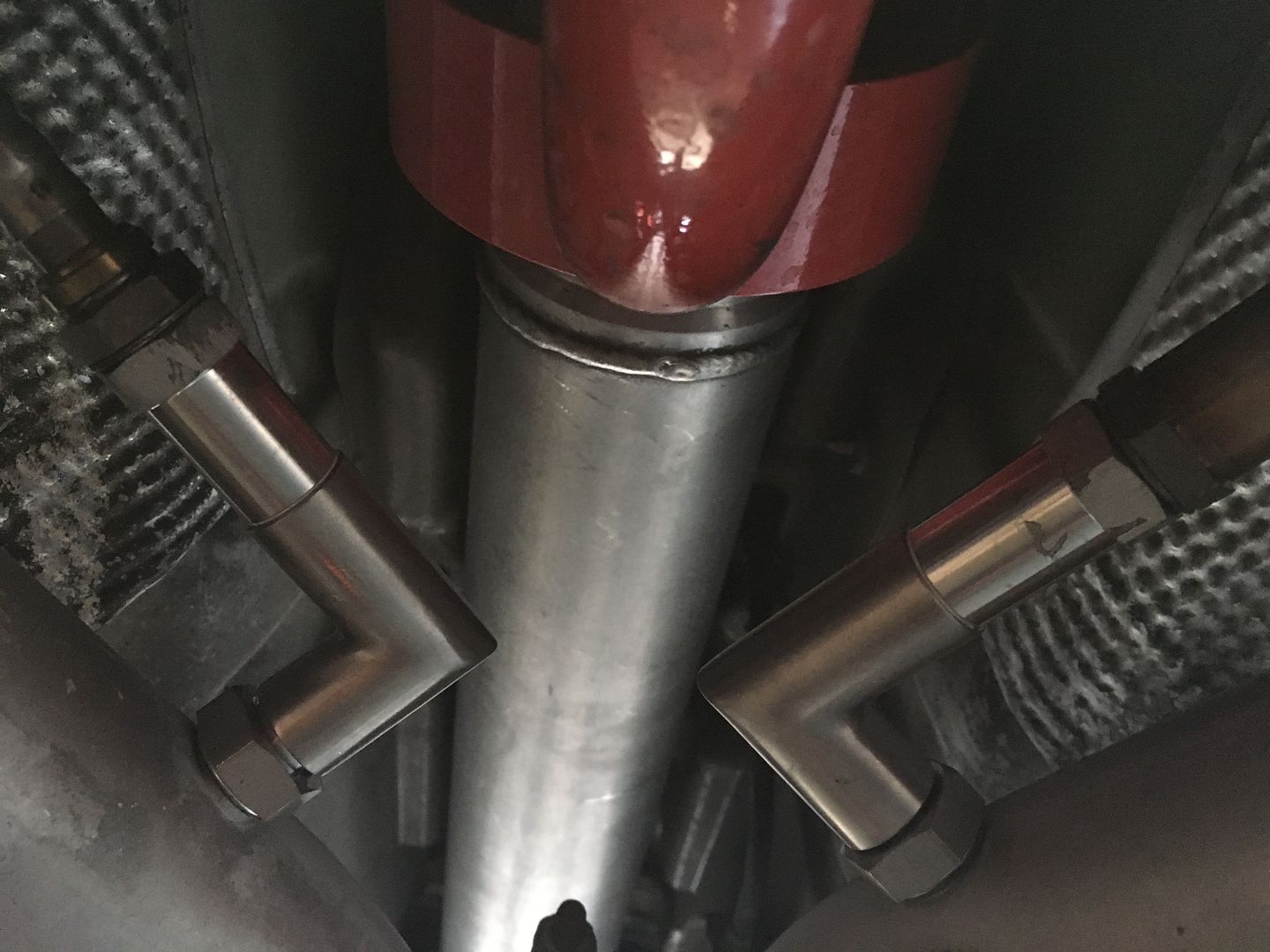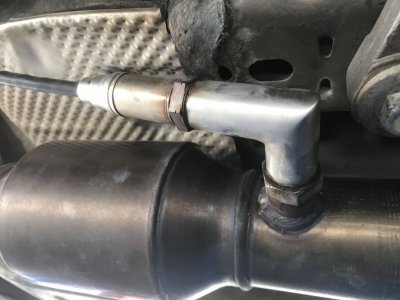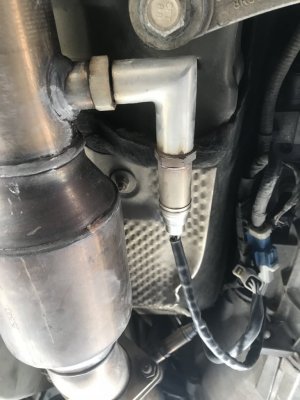GlassTop09
Senior Member
Hi All,
I was under my car messing around awhile back just after swapping all my O2 sensors from the "new" Ford OEM O2 sensors (F85F-9G444-BD....which are in reality Bosch #15717 O2 sensors w\ FoMoCo badging) back to NTK 22060/22500 O2 sensors (were FoMoCo OEM std O2 sensors when car was manufactured) & was looking at the post cat O2 sensors (installed using Big Daddies Garage 90* CEL Eliminators....running Kooks 1 5/8" LTH's w\ Kooks Catted X-Pipe using Kooks Hi Flow Race Cats-not the Kooks "Green" Cats due to getting MIL's. Eliminators are mounted in a 25* upward angle to eliminate water collection) & wondering if the readouts would change if I remounted the eliminators to be parallel (in same plane) w\ the O2 sensor bung instead of being angled upwards. Since initial install of these eliminators @ 25* up angle I've had no more issues w\ cat MIL DTC P0420/P0430 codes. So I got my tools & repositioned both eliminators parallel to the O2 sensor bungs to test this out.
After a couple of days driving (mostly in town) seeing all operate as usual I took my car out on an open road run of approx. 60 mi at hiway speeds between 60-70 MPH & during the drive back home the MIL came on. From the car showing no signs of any operational issues I assumed it had to be related to the post cat O2 sensors so when I got back home I hooked up my scan tool, checked & found the following DTC: P0139 Bank 1 Sensor 2 Circuit Slow to Respond. Researched this DTC which indicates that my B1S2 O2 sensor wasn't responding (making current) within a specific amount of time meaning that the O2 sensor readout was at the min end of the scale (or referencing to reference air which is at\close to .000v). Now these O2 sensors are brand new & verified operational before remounting the eliminators in parallel w\ sensor bung so what this told me is that once these eliminators were mounted in parallel w\ the O2 bung there was no more exhaust exchange or circulation occurring within thus trapped mostly O2 inside the eliminators which rendered the O2 sensor out of commission (stopped generating current) long enough to fail the PCM O2 sensor check test.
I then got back under the car, reset both eliminators back to the 25* up angle (as far as I could angle them up & still clear the unibody) then cleared the MIL to see if this MIL would return. After several days of operation since then (includes a 1,752 mi trip over 5 days) I have yet to see any MIL since & all Onboard Monitor Component data (the Mode 6 data) shows all O2 sensors passing all their monitor checks, all cat switch ratio data shows passing (this is the data the PCM is looking at--ratio of the front O2 sensor switching rate vs the rear O2 sensor switching rate--to determine if a cat has passed\failed efficiency) & all misfire monitor checks (1 of these checks is to determine the amount of cat damage associated to misfires) are all passing @ 0% w\ 0 misfires recorded for all 8 cylinders. This determined that these CEL eliminators need to be mounted in a position that would create some thermal exhaust circulation to occur so that the O2 sensors would operate within the expected O2 sensor test parameters as coded within the PCM for the PCM to determine proper operation of the O2 sensor as well as proper operation of any cat thus the amount of exhaust gas sampling volume rate to the O2 sensor is the determining factor...………...
This proved to me that there has to be some exhaust flow/circulation present for the rear O2 sensors to actually operate regardless of where they're mounted & the AMOUNT of exhaust flow volume (oxygen in particular) will determine how often they will switch. Now this isn't new in & of itself, but what is relevant is where they're mounted & the position that they're mounted will determine how much they will react as this controls the amount of exhaust sampling volume they see which determines the switching ratio vs the front pre-cat O2 sensor in addition to the varying amounts of unburnt oxygen present in the exhaust sample. So in essence to ensure that any cat will operate properly on a particular vehicle the cat should be designed to the same dimensions (or as close to it) w\ the same O2 sensor bung placement as the OEM cat that was designed for the vehicle's OEM engine design. The OEM cats for the 05-10 4.6L 3v were a clam shell design w\ the O2 sensor bung welded on the cat's clam shell body after the 1st substrate brick (in the center of the cat clam shell body at a 10 o'clock/2 o'clock position) & not on the 2 1/2" piping. This got me to think that w\ most of the aftermarket cats designed for this platform (w\ a few exceptions) the post O2 sensor bung location is actually in the wrong place which is potentially throwing the exhaust sampling volume rate off (much higher sampling volume) to the O2 sensor than OEM design which is accounting for a LOT of the cat P0420/P0430 codes & not necessarily the cat substrate's inability to process the exhaust volume....especially in conjunction w\ an unaltered OEM long block in NA form which will dictate maximum airflow capacity thus the max volume capacity of an OEM cat design at optimum A/F ratios (which will include the deltaP across the substrate at this max volume) thus NOT necessarily the aftermarket FBO components used w\ it (any FBO part, regardless of how well it is designed, will not allow the full air volume capacity of the OEM long block to be reached in NA form due to it's own operational design restrictions). This also explained to me as to why the only time these Kooks Hi Flow cats would "fail" & set the P0420\P0430 cat codes is when I would lug the engine too long at low speed in 5th gear instead of downshifting.....w\o doing this I never got a cat MIL light. The O2 sensor bung is welded in the post cat 2 1\2" piping & not welded on the cat's 4 1/2" OD outer substrate shell after the substrate brick inside...………..
So I have reached out to a couple of major aftermarket cat manufacturers & asked them both about this (won't reveal any names at this time) w/ 1 of these companies all but alluding to this reasoning of mine being true & stating that all their cat's O2 sensor location bungs are attached according to the OEM cat original design O2 sensor location but the other 1 giving me the std non answer position of stating that the vehicle undercarriage design will determine the O2 sensor placement but not answering to the O2 sensor location placement affecting the perceived cat efficiency by altering the exhaust sampling volume rate to the O2 sensor away from the OEM design...……...
After this I got under my car again & measured the distance 1/2" aft of the 45* bend of the Kooks exhaust pipe off the header collector to the front edge of the trans crossmember....came out to 17". This is more than enough room to accommodate a cat at the EPA Federal OEM dimensions of 4 1/4" OD x 11" L w\ the O2 sensor bung welded in the center of the cat's outer shell w\ 2-2 1/2" extensions added (2 brick substrate design total length of 15") to reattach back to the existing piping (need to be welded) or even a CARB FVN # certified OEM dimensioned cat @ 4" OD x 11" L w\ O2 sensor bung also welded in center of the cat shell housing (2 brick design) w\ 2-1/2" extensions added to reattach back to the existing piping (also welded) w\o interference......so I do not understand why most aftermarket cats don't extend the cat housing shell enough to put the O2 sensor bung on the cat's OD housing after the substrate brick...an extra 1" of shell extension would do it (only found 2 companies that do this across the board on their cats designed for the 05-10 S197 platform which meets the Fed EPA and\or CARB std due to meeting the OEM design std) instead of on the post cat piping which would slow down the exhaust sampling volume rate to the O2 sensor due to the expanded ID area of the cat's outer shell vs the ID area of the 2 1\2" exhaust piping relocating the O2 sensor's element farther away from the center of the exhaust flow so it doesn't get hit w\ too much exhaust volume to sample......just like the OEM cat is designed. There is more than enough room to easily mount the O2 sensor w\o coming into any resemblance of contact w\ the TR3650 transmission (can't say for an automatic as I ain't got 1 to measure).
So I'm gonna look into getting a used Kooks 2 1/2" O\R X-pipe (or H-pipe) that fits w\ my headers then getting a couple of these cats welded in to install on my car to then test them to see if they can handle my engine's exhaust output w\ the current FBO's, cams & tune w\o any eliminators & maintain proper cat efficiency w\o MIL's...…& maintain current HP\TQ levels…….
So I'm wondering how many of y'all are running a FBO & tuned 4.6 L 3V's in NA form w\ OEM exhaust/cats w\ rear O2 sensors active & not getting MIL's...……………….. ?
While I was at it I also looked up the dimensions of the OEM Fed EPA cat for the 07-12 GT500 (5.4L 4V SC V8) & found that it isn't any larger (4 1/4" OD x 9" L w\ total length of 13") than the OEM dimensions for the 05-10 4.6L 3V but the OEM O2 sensor location for these is not on the cat shell itself but is installed on the post cat 2 1\2" exhaust piping (but this car still uses the same NTK 22060/22500 O2 sensors as the GT) so it would seem that the OEM 4.6L 3V cat design should be capable of easily handling an OEM NA 4.6L 3V long block w\ FBO's, cams & tune w\o MIL's & maintain good exhaust flow...………….
The key IMHO is depending on the tune's AF ratio chosen for closed throttle/part throttle/WOT operation not being too far away from the OEM AF ratio used (especially rich) for the same area of operation to not overrun the cat's substrate w\ excessive NOx & unburnt HC's for the amount of unburnt oxygen present from switching pre-cat O2 sensors (how cats are fed oxygen to work instead of using a secondary air pump).
PS--This is another reason why the NTK 22060/22500 O2 sensors are a better design for these 4.6L 3V's is the operational switching voltage range of the sensor. The Bosch 15717 O2 sensor operational voltage switch range is .2v to .8v as opposed to the NTK's @ 0v to 1v. The NTK O2 sensors will allow for a wider operational range w\o going off scale (losing accuracy) which helps especially when FBO's or cams w\ tunes are installed but are especially helpful when cats are being used as the NTK's will do a much better job of feeding cats w\ sufficient O2 levels to facilitate them to maintain their efficiency.
Meant to type this but forgot.
I was under my car messing around awhile back just after swapping all my O2 sensors from the "new" Ford OEM O2 sensors (F85F-9G444-BD....which are in reality Bosch #15717 O2 sensors w\ FoMoCo badging) back to NTK 22060/22500 O2 sensors (were FoMoCo OEM std O2 sensors when car was manufactured) & was looking at the post cat O2 sensors (installed using Big Daddies Garage 90* CEL Eliminators....running Kooks 1 5/8" LTH's w\ Kooks Catted X-Pipe using Kooks Hi Flow Race Cats-not the Kooks "Green" Cats due to getting MIL's. Eliminators are mounted in a 25* upward angle to eliminate water collection) & wondering if the readouts would change if I remounted the eliminators to be parallel (in same plane) w\ the O2 sensor bung instead of being angled upwards. Since initial install of these eliminators @ 25* up angle I've had no more issues w\ cat MIL DTC P0420/P0430 codes. So I got my tools & repositioned both eliminators parallel to the O2 sensor bungs to test this out.
After a couple of days driving (mostly in town) seeing all operate as usual I took my car out on an open road run of approx. 60 mi at hiway speeds between 60-70 MPH & during the drive back home the MIL came on. From the car showing no signs of any operational issues I assumed it had to be related to the post cat O2 sensors so when I got back home I hooked up my scan tool, checked & found the following DTC: P0139 Bank 1 Sensor 2 Circuit Slow to Respond. Researched this DTC which indicates that my B1S2 O2 sensor wasn't responding (making current) within a specific amount of time meaning that the O2 sensor readout was at the min end of the scale (or referencing to reference air which is at\close to .000v). Now these O2 sensors are brand new & verified operational before remounting the eliminators in parallel w\ sensor bung so what this told me is that once these eliminators were mounted in parallel w\ the O2 bung there was no more exhaust exchange or circulation occurring within thus trapped mostly O2 inside the eliminators which rendered the O2 sensor out of commission (stopped generating current) long enough to fail the PCM O2 sensor check test.
I then got back under the car, reset both eliminators back to the 25* up angle (as far as I could angle them up & still clear the unibody) then cleared the MIL to see if this MIL would return. After several days of operation since then (includes a 1,752 mi trip over 5 days) I have yet to see any MIL since & all Onboard Monitor Component data (the Mode 6 data) shows all O2 sensors passing all their monitor checks, all cat switch ratio data shows passing (this is the data the PCM is looking at--ratio of the front O2 sensor switching rate vs the rear O2 sensor switching rate--to determine if a cat has passed\failed efficiency) & all misfire monitor checks (1 of these checks is to determine the amount of cat damage associated to misfires) are all passing @ 0% w\ 0 misfires recorded for all 8 cylinders. This determined that these CEL eliminators need to be mounted in a position that would create some thermal exhaust circulation to occur so that the O2 sensors would operate within the expected O2 sensor test parameters as coded within the PCM for the PCM to determine proper operation of the O2 sensor as well as proper operation of any cat thus the amount of exhaust gas sampling volume rate to the O2 sensor is the determining factor...………...
This proved to me that there has to be some exhaust flow/circulation present for the rear O2 sensors to actually operate regardless of where they're mounted & the AMOUNT of exhaust flow volume (oxygen in particular) will determine how often they will switch. Now this isn't new in & of itself, but what is relevant is where they're mounted & the position that they're mounted will determine how much they will react as this controls the amount of exhaust sampling volume they see which determines the switching ratio vs the front pre-cat O2 sensor in addition to the varying amounts of unburnt oxygen present in the exhaust sample. So in essence to ensure that any cat will operate properly on a particular vehicle the cat should be designed to the same dimensions (or as close to it) w\ the same O2 sensor bung placement as the OEM cat that was designed for the vehicle's OEM engine design. The OEM cats for the 05-10 4.6L 3v were a clam shell design w\ the O2 sensor bung welded on the cat's clam shell body after the 1st substrate brick (in the center of the cat clam shell body at a 10 o'clock/2 o'clock position) & not on the 2 1/2" piping. This got me to think that w\ most of the aftermarket cats designed for this platform (w\ a few exceptions) the post O2 sensor bung location is actually in the wrong place which is potentially throwing the exhaust sampling volume rate off (much higher sampling volume) to the O2 sensor than OEM design which is accounting for a LOT of the cat P0420/P0430 codes & not necessarily the cat substrate's inability to process the exhaust volume....especially in conjunction w\ an unaltered OEM long block in NA form which will dictate maximum airflow capacity thus the max volume capacity of an OEM cat design at optimum A/F ratios (which will include the deltaP across the substrate at this max volume) thus NOT necessarily the aftermarket FBO components used w\ it (any FBO part, regardless of how well it is designed, will not allow the full air volume capacity of the OEM long block to be reached in NA form due to it's own operational design restrictions). This also explained to me as to why the only time these Kooks Hi Flow cats would "fail" & set the P0420\P0430 cat codes is when I would lug the engine too long at low speed in 5th gear instead of downshifting.....w\o doing this I never got a cat MIL light. The O2 sensor bung is welded in the post cat 2 1\2" piping & not welded on the cat's 4 1/2" OD outer substrate shell after the substrate brick inside...………..
So I have reached out to a couple of major aftermarket cat manufacturers & asked them both about this (won't reveal any names at this time) w/ 1 of these companies all but alluding to this reasoning of mine being true & stating that all their cat's O2 sensor location bungs are attached according to the OEM cat original design O2 sensor location but the other 1 giving me the std non answer position of stating that the vehicle undercarriage design will determine the O2 sensor placement but not answering to the O2 sensor location placement affecting the perceived cat efficiency by altering the exhaust sampling volume rate to the O2 sensor away from the OEM design...……...
After this I got under my car again & measured the distance 1/2" aft of the 45* bend of the Kooks exhaust pipe off the header collector to the front edge of the trans crossmember....came out to 17". This is more than enough room to accommodate a cat at the EPA Federal OEM dimensions of 4 1/4" OD x 11" L w\ the O2 sensor bung welded in the center of the cat's outer shell w\ 2-2 1/2" extensions added (2 brick substrate design total length of 15") to reattach back to the existing piping (need to be welded) or even a CARB FVN # certified OEM dimensioned cat @ 4" OD x 11" L w\ O2 sensor bung also welded in center of the cat shell housing (2 brick design) w\ 2-1/2" extensions added to reattach back to the existing piping (also welded) w\o interference......so I do not understand why most aftermarket cats don't extend the cat housing shell enough to put the O2 sensor bung on the cat's OD housing after the substrate brick...an extra 1" of shell extension would do it (only found 2 companies that do this across the board on their cats designed for the 05-10 S197 platform which meets the Fed EPA and\or CARB std due to meeting the OEM design std) instead of on the post cat piping which would slow down the exhaust sampling volume rate to the O2 sensor due to the expanded ID area of the cat's outer shell vs the ID area of the 2 1\2" exhaust piping relocating the O2 sensor's element farther away from the center of the exhaust flow so it doesn't get hit w\ too much exhaust volume to sample......just like the OEM cat is designed. There is more than enough room to easily mount the O2 sensor w\o coming into any resemblance of contact w\ the TR3650 transmission (can't say for an automatic as I ain't got 1 to measure).
So I'm gonna look into getting a used Kooks 2 1/2" O\R X-pipe (or H-pipe) that fits w\ my headers then getting a couple of these cats welded in to install on my car to then test them to see if they can handle my engine's exhaust output w\ the current FBO's, cams & tune w\o any eliminators & maintain proper cat efficiency w\o MIL's...…& maintain current HP\TQ levels…….
So I'm wondering how many of y'all are running a FBO & tuned 4.6 L 3V's in NA form w\ OEM exhaust/cats w\ rear O2 sensors active & not getting MIL's...……………….. ?
While I was at it I also looked up the dimensions of the OEM Fed EPA cat for the 07-12 GT500 (5.4L 4V SC V8) & found that it isn't any larger (4 1/4" OD x 9" L w\ total length of 13") than the OEM dimensions for the 05-10 4.6L 3V but the OEM O2 sensor location for these is not on the cat shell itself but is installed on the post cat 2 1\2" exhaust piping (but this car still uses the same NTK 22060/22500 O2 sensors as the GT) so it would seem that the OEM 4.6L 3V cat design should be capable of easily handling an OEM NA 4.6L 3V long block w\ FBO's, cams & tune w\o MIL's & maintain good exhaust flow...………….
The key IMHO is depending on the tune's AF ratio chosen for closed throttle/part throttle/WOT operation not being too far away from the OEM AF ratio used (especially rich) for the same area of operation to not overrun the cat's substrate w\ excessive NOx & unburnt HC's for the amount of unburnt oxygen present from switching pre-cat O2 sensors (how cats are fed oxygen to work instead of using a secondary air pump).
PS--This is another reason why the NTK 22060/22500 O2 sensors are a better design for these 4.6L 3V's is the operational switching voltage range of the sensor. The Bosch 15717 O2 sensor operational voltage switch range is .2v to .8v as opposed to the NTK's @ 0v to 1v. The NTK O2 sensors will allow for a wider operational range w\o going off scale (losing accuracy) which helps especially when FBO's or cams w\ tunes are installed but are especially helpful when cats are being used as the NTK's will do a much better job of feeding cats w\ sufficient O2 levels to facilitate them to maintain their efficiency.
Meant to type this but forgot.
Last edited:





